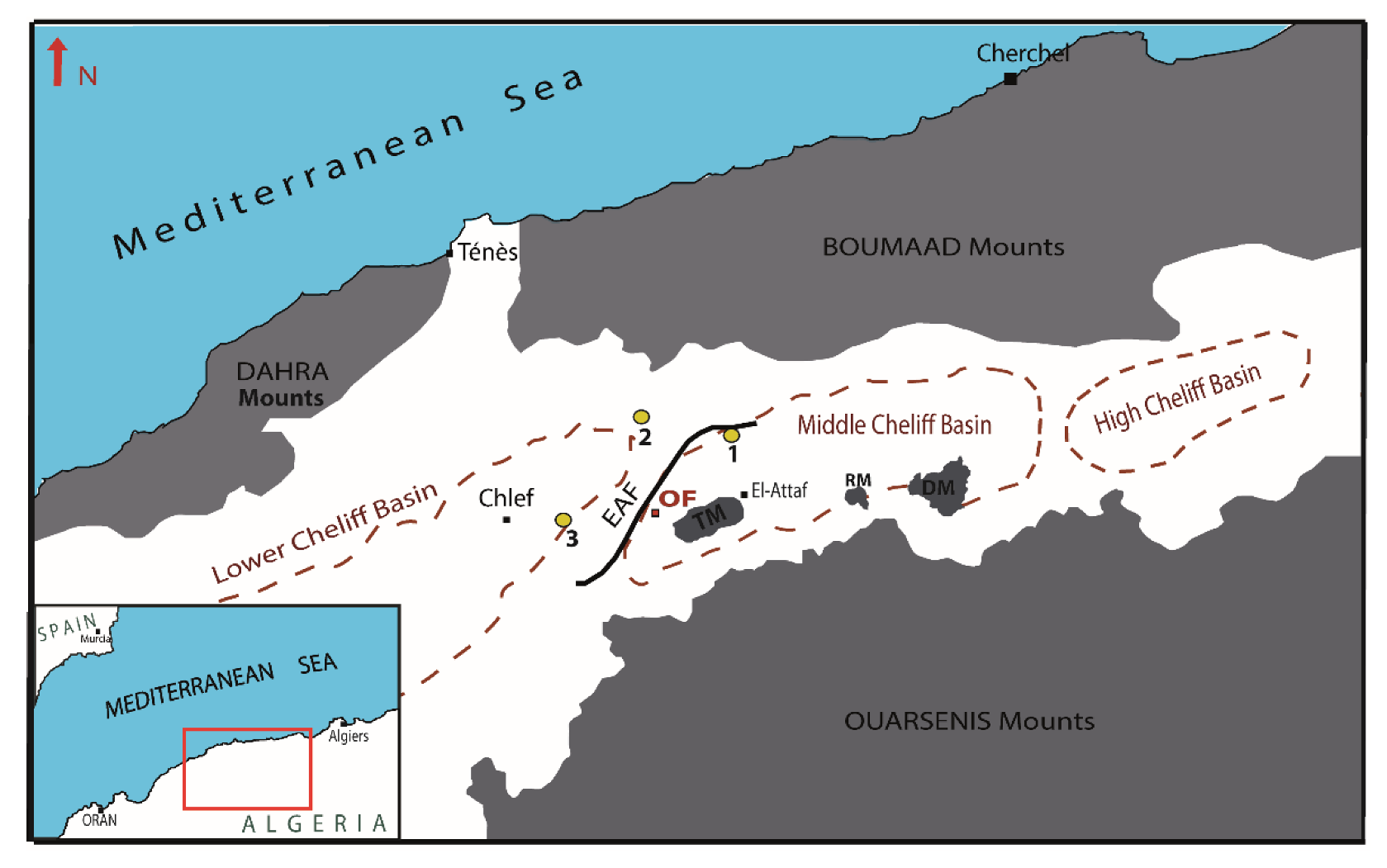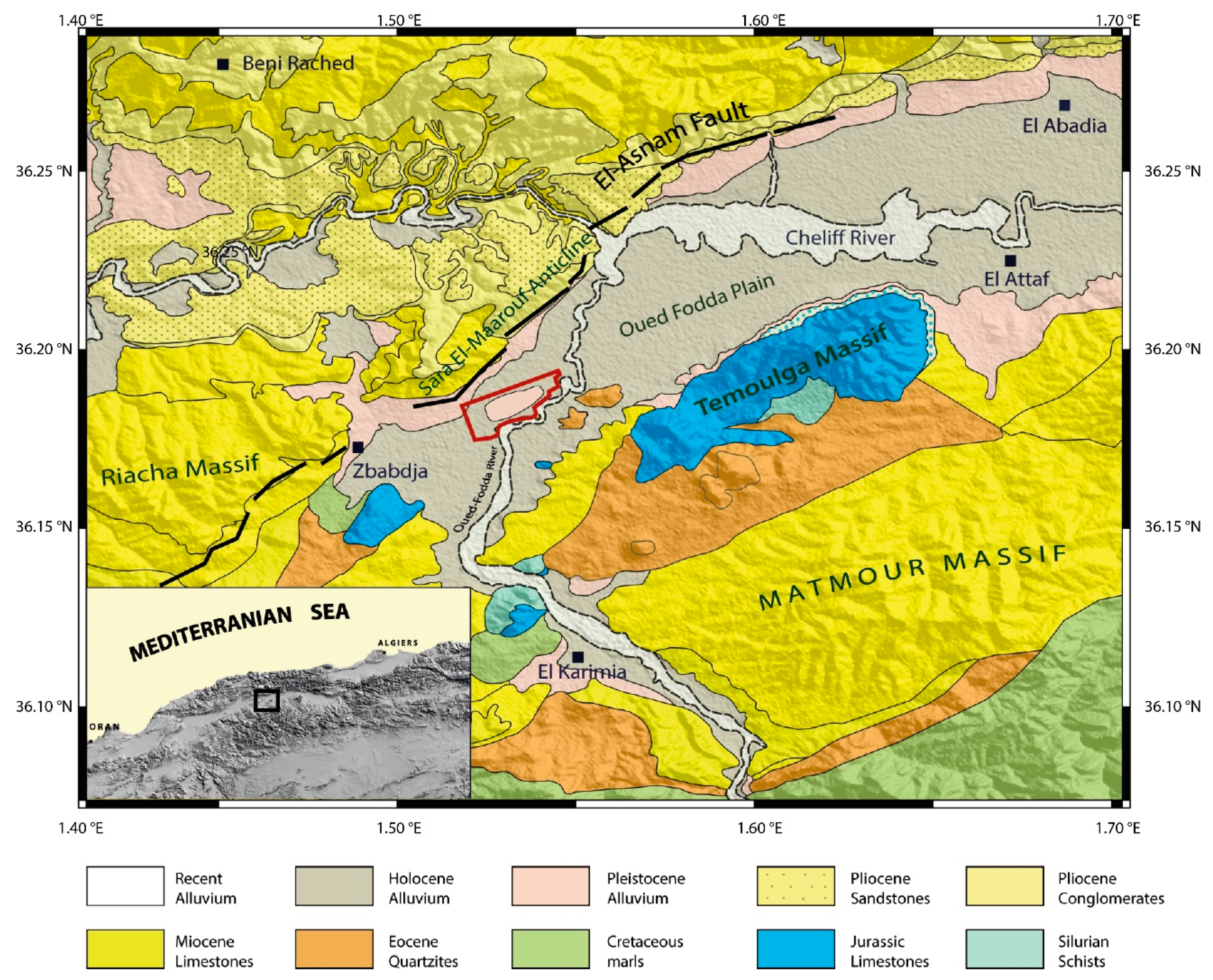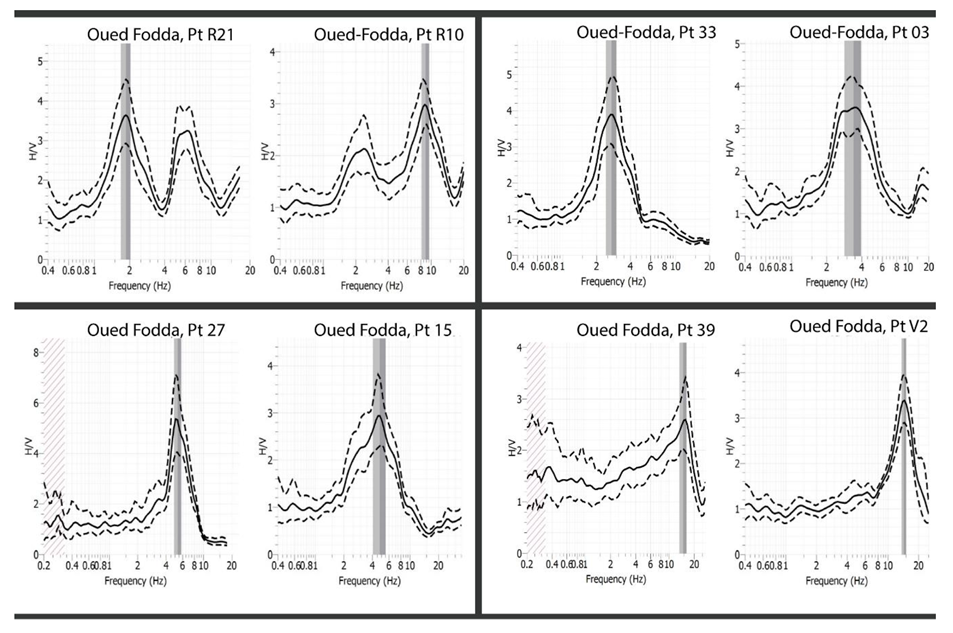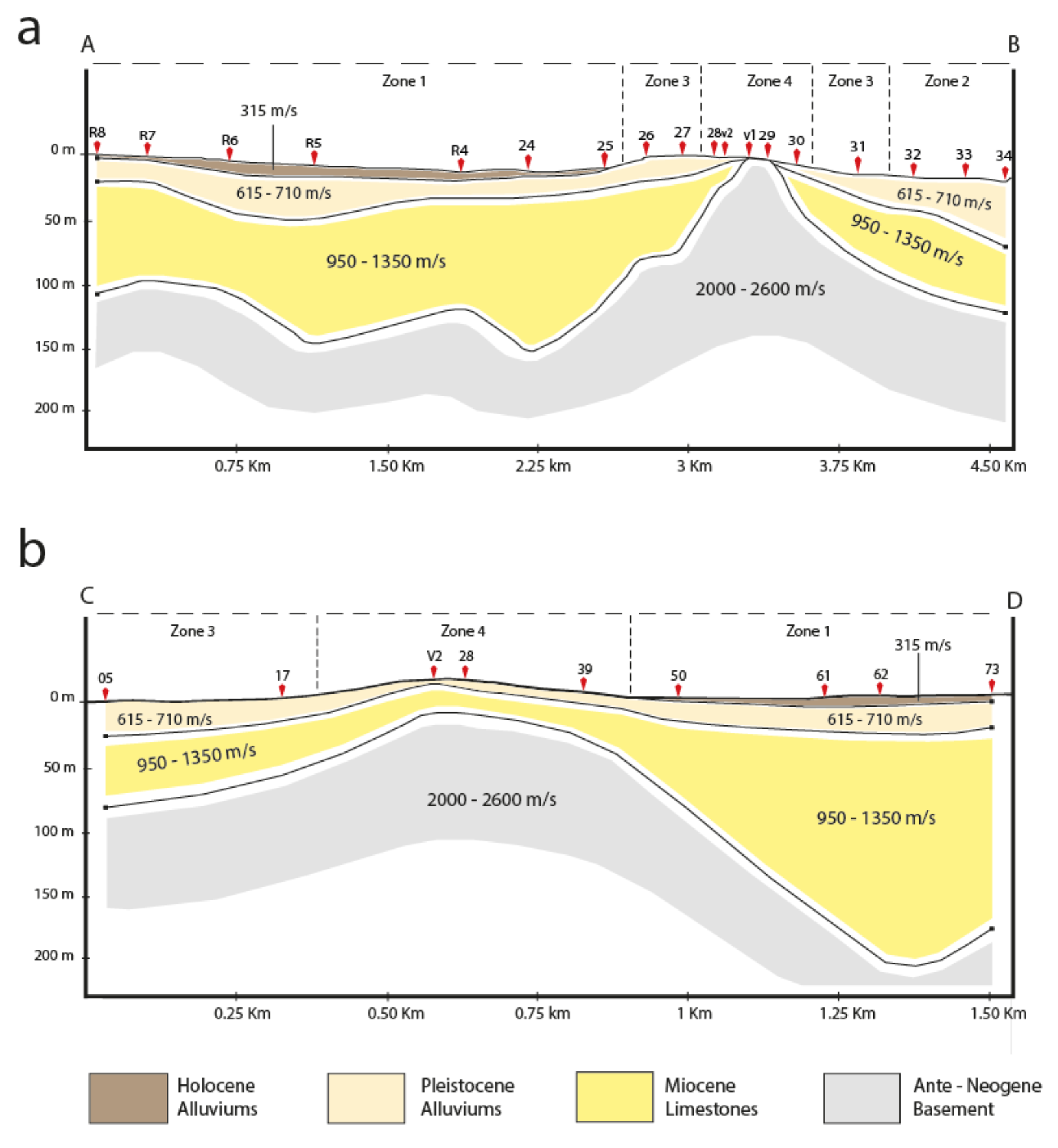A Shear-Wave Velocity Model in the City of Oued-Fodda (Northern Algeria) from Rayleigh Wave Ellipticity Inversion
Abstract
1. Introduction
2. Geological Framework
3. Methodology
3.1. The Horizontal to Vertical Spectral Ratio (HVSR) Technique
3.2. Rayleigh Wave Ellipticity Curve Extraction and Inversion
4. Data Acquisition and Processing
4.1. Ambient Vibrations
4.2. Zonation of the Study Area Using Experimental HVSR Curves
- Zone 1:
- This zone includes HVSR curves with two peaks.The fundamental one, f0, ranges from 1.8 to 3 Hz, meanwhile the second peak, f1, ranges from 6.5 to 15 Hz. The corresponding amplitudes range from 2 to 4 for both peaks (e.g., Pt R21 and Pt R10 in Figure 5).
- Zone 2:
- This zone includes 10 recordings with clear f0 between 2.5 and 4 Hz, with amplitudes around 3.5 (e.g., Pt 03 and Pt 33 in Figure 5).
- Zone 3:
- A total set of 15 recordings with clear f0 between 5 and 7 Hz. The corresponding amplitudes vary from 2.5 to 6 (e.g., Pt 15 and Pt 27 in Figure 5).
- Zone 4:
- This zone covers the rock knoll in the central part of the city, with eight clear HVSR peaks between 12.5 and 15 Hz. The amplitudes range from 2.5 to 3.5 (e.g., Pt V2 and Pt 39 in Figure 5).
4.3. Geotechnical Information
4.4. Rayleigh Wave Ellipticity Curve
5. Results and Discussions
5.1. Soil Frequency Peaks and the Corresponding Amplitudes
5.2. Shear Wave Velocity Profiles
5.3. 2D Cross-Sections
6. Conclusions
- The analysis of the ambient vibrations recordings using the HVSR method shows the predominance of single frequency peak curves in the center of the city (f0 ranges between 2.5 and 15 Hz). In the area surrounding the city center, two frequency peak curves are observed. The fundamental frequency, f0, ranges between 1.8 and 3.5 Hz. The second frequency peak, f1, which varies between 6.5 and 15 Hz, could be caused by the impedance contrast between the Holocene and Pleistocene deposits at shallow depths (<10 m).
- The fundamental frequencies range between 1.8 and 15 Hz, this large variation is due to the local geology. The high frequency peaks (12.5–15 Hz) obtained on the knoll situated in the center of the city, along with the flat H/V curves confirm the assumption made by the WCC report [7] that this knoll is a bedrock outcrop.
- From the inversion of the Rayleigh wave ellipticity curves, we obtained a four-layer model. The topmost layer consists of Holocene alluviums (Vs varies from 280 to 330 m/s), with a thickness less than 10 m. The second layer is composed of Pleistocene clays and conglomerates (Vs from 615 to 710 m/s). The bottom layer of the sedimentary deposits is composed of blue marls of Miocene age (Vs from 950 to 1350 m/s). The ante-Neogene bedrock, most probably composed of Mesozoic limestones and schists (Vs from 2000 to 2600 m/s), is at very shallow depths in the central part of the city (0–25 m). In the rest of the study area, the depth of the bedrock varies between 80 m and 198 m.
- The results of the RWE inversion show clearly the existence of lateral variations of the shear-wave velocities and the sediments thickness in the Oued-Fodda city.
- The obtained shear wave velocity models can be further used for strong ground motion simulation in the Middle Chellif Basin.
- The largest amplification factor is about 6 and is mainly observed west and south of the city center. Fortunately, in the city center where the buildings are mainly single floor (building frequency close to the soil fundamental frequency), the amplification factor is very low (~2).
- The city of Oued-Fodda is growing southward, where the largest thickness of the sedimentary cover is obtained. Site effects investigations should be taken into account, especially for growing cities located in high-level seismic hazard zones, in order to minimize potential building damages due to earthquakes. Since the north of Algeria is characterized by moderate to high seismicity, this study is a good example to follow for bigger Algerian cities.
Author Contributions
Funding
Acknowledgments
Conflicts of Interest
References
- Yelles-Chaouche, A.; Boudiaf, A.; Djellit, H.; Bracene, R. La tectonique active de la région nord-algérienne. Comptes Rendus Geosci. 2006, 338, 126–139. [Google Scholar] [CrossRef]
- Meghraoui, M.; Cisternas, A.; Philip, H. Seismotectonics of the lower Cheliff basin: Structural background of the El Asnam (Algeria) earthquake. Tectonics 1986, 5, 809–836. [Google Scholar] [CrossRef]
- Perrodon, A. Etude géologique des bassins sublittoraux de l’Algérie occidentale. Publ. Serv. Carte Géol. del’Algérie. NS Bull. 1957, 12, 328. [Google Scholar]
- Rothé, J. Le tremblement de terre d’Orléansville et la séismicité de l’Algérie. La Nat. 1955, 3237, 1–9. [Google Scholar]
- McKenzie, D. Active tectonics of the Mediterranean region. Geophys. J. Int. R. Astron. Soc. 1972, 30, 109–185. [Google Scholar] [CrossRef]
- Ouyed, M. Le Tremblement De Terre d’El Asnam Du 10 Octobre 1980: Étude Des Répliques. Ph.D. Thesis, Universite Scientifique et Medicale de Grenoble, Grenoble, France, 1981. [Google Scholar]
- Woodward-Clyde-Consultants. Seismic Microzonation of Ech-Chellif Region, Algeria; Report Prepared for Organisme de Controle Technique de la Construction (CTC); CTC: Algiers, Algeria, 1984. [Google Scholar]
- Parolai, S.; Bormann, P.; Milkereit, C. Assessment of the natural frequency of the sedimentary cover in the Cologne area (Germany) using noise measurements. J. Earthq. Eng. 2001, 5, 541–564. [Google Scholar] [CrossRef]
- Mundepi, A.; Galiana-Merino, J.; Lindholm, C. Soil characteristics and site effect assessment in the city of Delhi (India) using H/V and f–k methods. Soil Dyn. Earthq. Eng. 2010, 30, 591–599. [Google Scholar] [CrossRef]
- Rosa-Cintas, S.; Galiana-Merino, J.; Molina-Palacios, S.; Rosa-Herranz, J.; García-Fernández, M.; Jiménez, M. Soil characterization in urban areas of the Bajo Segura Basin (Southeast Spain) using H/V, F–K and ESAC methods. J. Appl. Geophys. 2011, 75, 543–557. [Google Scholar] [CrossRef]
- Rosa-Cintas, S.; Clavero, D.; Delgado, J.; López-Casado, C.; Galiana-Merino, J.J.; Garrido, J. Characterization of the shear wave velocity in the metropolitan area of Málaga (S Spain) using the H/V technique. Soil Dyn. Earthq. Eng. 2017, 92, 433–442. [Google Scholar] [CrossRef]
- Sen, M.K.; Stoffa, P.L. Nonlinear one-dimensional seismic waveform inversion using simulated annealing. Geophysics 1991, 56, 1624–1638. [Google Scholar] [CrossRef]
- Sambridge, M.; Drijkoningen, G. Genetic algorithms in seismic waveform inversion. Geophys. J. Int. 1992, 109, 323–342. [Google Scholar] [CrossRef]
- Sambridge, M. Geophysical inversion with a neighbourhood algorithm—I. Searching a parameter space. Geophys. J. Int. 1999, 138, 479–494. [Google Scholar] [CrossRef]
- Wathelet, M. An improved neighborhood algorithm: Parameter conditions and dynamic scaling. Geophys. Res. Lett. 2008, 35. [Google Scholar] [CrossRef]
- Layadi, K.; Semmane, F.; Yelles-Chaouche, A. Site-Effects Investigation in the City of Chlef (Formerly El-Asnam), Algeria, Using Earthquake and Ambient Vibration Data. Bull. Seismol. Soc. Am. 2016, 106, 2185–2196. [Google Scholar] [CrossRef]
- Layadi, K.; Semmane, F.; Yelles-Chaouche, A. S-wave velocity structure of Chlef City, Algeria, by inversion of Rayleigh wave ellipticity. Near Surf.Geophys. 2018, 16, 328–339. [Google Scholar] [CrossRef]
- Nogoshi, M.; Igarashi, T. On the amplitude characteristics of ambient noise (Part 2). J. Seismol. Soc. Jpn. 1971, 24, 26–40. [Google Scholar]
- Nakamura, Y. A method for dynamic characteristics estimation of subsurface using microtremor on the ground surface. Railw. Tech. Res. Inst. Q. Rep. 1989, 30, 25–33. [Google Scholar]
- Hobiger, M.; Bard, P.Y.; Cornou, C.; Le Bihan, N. Single station determination of Rayleigh wave ellipticity by using the random decrement technique (RayDec). Geophys. Res. Lett. 2009, 36. [Google Scholar] [CrossRef]
- Hobiger, M.; Cornou, C.; Wathelet, M.; Giulio, G.D.; Knapmeyer-Endrun, B.; Renalier, F.; Bard, P.-Y.; Savvaidis, A.; Hailemikael, S.; Le, B.N. Ground structure imaging by inversions of Rayleigh wave ellipticity: Sensitivity analysis and application to European strong-motion sites. Geophys. J. Int. 2012, 192, 207–229. [Google Scholar] [CrossRef]
- Meghraoui, M. Etude Neotectonique de la Region nord-est d’El Asnam: Relation avec le Seisme du 10.10.1980. Ph.D. Thesis, Univ. Paris VII, Paris, France, 1982. [Google Scholar]
- Meghraoui, M. Géologie des Zones Sismiques du Nord de l’Algérie: Paléosismologie, Tectonique Active et Synthèse Sismotectonique. Ph.D. Thesis, Univ. Paris-Sud, Paris, France, 1988. [Google Scholar]
- Aïfa, T.; Idres, M. Indentation model usinggravityanomaly and anisotropy of magneticsusceptibility: Consequences on nappe rotations in the Chélif Basin, Algeria. Open Geol. J. 2010, 4, 105–116. [Google Scholar]
- Bonnefoy-Claudet, S.; Cotton, F.; Bard, P.-Y. The nature of noise wavefield and its applications for site effects studies: A literature review. Earth Sci. Rev. 2006, 79, 205–227. [Google Scholar] [CrossRef]
- Brives, A. Les Terrains Miocènes du Bassin du Chélif et du Dahra; Imprimerie, P. Fontana & Cie: Algiers, Algeria, 1897. [Google Scholar]
- Oubaiche, E.H.; Chatelain, J.L.; Bouguern, A.; Bensalem, R.; Machane, D.; Hellel, M.; Khaldaoui, F.; Guillier, B. Experimental relationship between ambient vibration H/V peak amplitude and shear-wave velocity contrast. Seismol. Res. Lett. 2012, 83, 1038–1046. [Google Scholar] [CrossRef]
- Mucciarelli, M.; Gallipoli, M.R.; Arcieri, M. The stability of the horizontal-to-vertical spectral ratio of triggered noise and earthquake recordings. Bull. Seismol. Soc. Am. 2003, 93, 1407–1412. [Google Scholar] [CrossRef]
- Rosa-Cintas, S.; Galiana-Merino, J.; Rosa-Herranz, J.; Molina, S.; Martínez-Esplá, J. Polarization analysis in the stationary wavelet packet domain: Application to HVSR method. Soil Dyn. Earthq. Eng. 2012, 42, 246–254. [Google Scholar] [CrossRef]
- Fäh, D.; Kind, F.; Giardini, D. A theoretical investigation of average H/V ratios. Geophys. J. Int. 2001, 145, 535–549. [Google Scholar] [CrossRef]
- Poggi, V.; Fäh, D. Estimating Rayleigh wave particle motion from three-component array analysis of ambient vibrations. Geophys. J. Int. 2010, 180, 251–267. [Google Scholar] [CrossRef]
- Daubechies, I. Ten Lectures on Wavelets. Comput. Phys. 1992, 6, 697. [Google Scholar] [CrossRef]
- Asmussen, J.C. Modal Analysis Based on the Random Decrement Technique: Application to Civil Engineering Structures. Ph.D. Thesis, Department of Mechanical Engineering, Aalborg University, Aalborg, Denmark, 1997. [Google Scholar]
- Wathelet, M. Array Recordings of Ambient Vibrations: Surface-Wave Inversion. Ph.D. Thesis, Liége University, Liège, Belgium, 2005. [Google Scholar]
- Castellaro, S.; Mulargia, F. VS 30 estimates using constrained H/V measurements. Bull. Seismol. Soc. Am. 2009, 99, 761–773. [Google Scholar] [CrossRef]
- Guidelines for the Implementation of the H/V Spectral Ratio Technique on Ambient Vibrations. SESAME European Research Project, Deliverable D23.12 (WP12). Available online: Ftp://ftp.geo.uib.no/pub/seismo/SOFTWARE/SESAME/USER-GUIDELINES/SESAME-HV-User-Guidelines.pdf (accessed on 20 November 2019).
- Konno, K.; Ohmachi, T. Ground-motion characteristics estimated from spectral ratio between horizontal and vertical components of microtremor. Bull. Seismol. Soc. Am. 1998, 88, 228–241. [Google Scholar]
- Talaganov, K.; Aleksovski, D.; Milutinovic, Z.; Ameur, B.; Arsovski, M.; Jancevski, J.; Andreevski, V. Studies for elaboration of the code for repair and strengthening of damaged buildings in the region of El Asnam: Engineering geology, geotechnical and geophysical characteristics of the town of El Asnam and other sites. Rep. IZIIS 1982, 82-55. [Google Scholar]
- ANRH (Agence Nationale des Ressources Hydrauliques). Available online: http://www.anrh.dz (accessed on 29 September 2019).
- Bellalem, F. Identification de la Structure Tridimensionnelle en Vitesse Sismique dans la Région de Chlef (Algérie) à Partir des Données Sismologique par tomoDD et LOTOS. Ph.D. Thesis, Univ. Ferhatabbas, Setif, Algeria, 2015. [Google Scholar]









| Zone | Epoch | Thickness (m) | Vp (m/s) | Vs (m/s) | Density (Kg/m3) | References |
|---|---|---|---|---|---|---|
| Z1 | Holocene | 0–40 | 600–1000 | 315 | 1700–1900 | [7] |
| Pleistocene | 10–70 | 1800–2000 | 500–750 | 1950–2200 | [38] | |
| Miocene | 40–170 | 2500–3500 | 900–1400 | 2100–2400 | [39] | |
| Z2 | Pleistocene | 0–50 | 1800–2200 | 500–800 | 1950–2250 | [7] |
| Miocene | 30–130 | 2500–3500 | 900–1400 | 2100–2400 | [38] | |
| Z3 | Pleistocene | 0–40 | 1800–2000 | 500–750 | 1950–2200 | [7] |
| Miocene | 20–60 | 2500–3500 | 900–1400 | 2100–2400 | [38] | |
| Z4 | Pleistocene | 0–15 | 1500–2000 | 450–750 | 1900–2200 | [7] |
| Miocene | 10–30 | 2500–3500 | 900–1400 | 2100–2400 | [38] |
© 2020 by the authors. Licensee MDPI, Basel, Switzerland. This article is an open access article distributed under the terms and conditions of the Creative Commons Attribution (CC BY) license (http://creativecommons.org/licenses/by/4.0/).
Share and Cite
Issaadi, A.; Semmane, F.; Yelles-Chaouche, A.; Galiana-Merino, J.J.; Layadi, K. A Shear-Wave Velocity Model in the City of Oued-Fodda (Northern Algeria) from Rayleigh Wave Ellipticity Inversion. Appl. Sci. 2020, 10, 1717. https://doi.org/10.3390/app10051717
Issaadi A, Semmane F, Yelles-Chaouche A, Galiana-Merino JJ, Layadi K. A Shear-Wave Velocity Model in the City of Oued-Fodda (Northern Algeria) from Rayleigh Wave Ellipticity Inversion. Applied Sciences. 2020; 10(5):1717. https://doi.org/10.3390/app10051717
Chicago/Turabian StyleIssaadi, Abdelouahab, Fethi Semmane, Abdelkrim Yelles-Chaouche, Juan José Galiana-Merino, and Khalissa Layadi. 2020. "A Shear-Wave Velocity Model in the City of Oued-Fodda (Northern Algeria) from Rayleigh Wave Ellipticity Inversion" Applied Sciences 10, no. 5: 1717. https://doi.org/10.3390/app10051717
APA StyleIssaadi, A., Semmane, F., Yelles-Chaouche, A., Galiana-Merino, J. J., & Layadi, K. (2020). A Shear-Wave Velocity Model in the City of Oued-Fodda (Northern Algeria) from Rayleigh Wave Ellipticity Inversion. Applied Sciences, 10(5), 1717. https://doi.org/10.3390/app10051717







